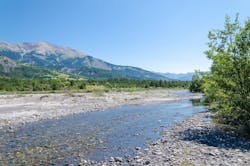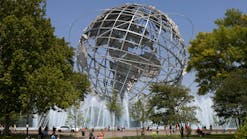About the author:
Garth Englehorn is senior project manager with NV5. Engelhorn can be reached at [email protected].
by Garth Engelhorn
undefinedAccording to the U.S. Drought Monitor, as of May 2021, 100% of California is in drought, with nearly 75% of the state in extreme or exceptional drought. Let that sink in for a moment. Following a very dry winter with below average statewide Sierra Nevada snowpack and below average rainfall, California and the Southwest (California, Nevada, Arizona, Utah, Colorado, New Mexico) are heading towards a significant and prolonged drought.
The drought has essentially doubled in coverage over the last year and intensified, with 93% of the entire Southwest in drought and 38% of the Southwest in exceptional (D4) drought, rapidly up from zero one year ago. The Southwest was essentially drought free a year ago, and the rapid expansion and intensification of drought should capture your attention. The reservoir levels across California and the Southwest are already below or well below normal, having never fully recovered from the previous five-year drought. The current outlooks for the reservoir storage levels and water supply volumes are concerning. In addition, the lack of snowmelt from the remaining snowpack in the Sierra Nevada is not going to help California’s reservoirs. The reoccurrence of drought conditions across the Southwest has been a common theme over the past 20 years, including prolonged droughts in the early 2000s and the mid-2010s.
The current drought developed in May 2020 and has been rapidly increasing in coverage and intensity fueled by last year’s record setting heat waves and lack of moisture over the winter. Adding to the concern, the NOAA National Weather Service Climate Prediction Center forecasts higher chances of above-normal temperatures for the summer and equal chances to below-normal precipitation, due to the uncertainty of the summer monsoon. Summer 2021 could be similar to the record-setting heat waves of 2020 and a wildfire season that shattered records and burned more than 10.2 million acres across the western states. In California, more than 4.1 million acres burned, more than doubling the previous annual record, and the dense wildfire smoke affected millions of people with hazardous air quality.
California and the western states are in for another year of exceptionally high fire risk. In fact, California has already experienced a significant increase in the number of wildfires and acres burned compared to this time last year. With widespread drought developing, above normal significant fire potential is anticipated across much of the Southwest. In addition, post-fire vegetation recovery from the 2020 burn scars has been limited due to the lack of winter rains, resulting in the potential for significant post-fire sediment and debris flows as experienced in previous years with devastating mudflow events.
Drought, water scarcity, heat waves, fires, mudflows. That is a lot of bad news, but one thing is certain, we are more prepared than we were 10 years ago, and we can work together to mitigate the potential impacts to communities and water resources.
Local, state, and federal government agencies are continually working on programs to improve drought preparedness and water resiliency. Urban water conservation, water recycling and storm water capture can all play a large role in curbing the impacts of this drought. For instance, storm water capture and reuse projects play a crucial role to further increase water supply, improve receiving water quality, reduce reliance on imported water, and help industries comply with strict water quality permits. Every time it rains, untreated storm water runs off urban areas, flushes pollutants into waterways, and reduces the amount of water that can recharge groundwater basins. The implementation of large scale regional storm water capture projects and the use of widespread green infrastructure improvements, such as rain barrels, green roofs, permeable pavers, and other low impact development efforts will increase water resiliency and improve water quality.
Recycled water can also provide a significant source of water and reduce the demand on current supply sources. Communities have greatly expanded the use of recycled water for landscape irrigation, agriculture and industrial purposes. In San Diego, the Pure Water San Diego Program will use water purification technology to clean recycled water to produce high-quality drinking water, reducing the city’s dependence on imported water.
Water Conservation
Water conservation and efficiency is an area that both individuals and local agencies can use. We should expect various levels of voluntary and mandatory water conservation measures and cutbacks soon. Our local water utilities can reduce water use by repairing aging water supply infrastructure and working with local businesses and other large water consumers to find solutions for water conservation. The local water utilities and storm water agencies need to ramp up public outreach programs to communicate the importance of water conservation, outline the steps the agencies are taking and provide recommendations for the public participation and action. Simple steps to reduce household water usage include the following:
- Utilize water efficient appliances and plumbing fixtures;
- Take shorter showers and turn off the water while brushing your teeth or shaving;
- Run the washer less frequently and only when you have a full load;
- Adhere to the local water use restrictions and;
- Reduce outdoor water usage by using drought-tolerant plants and use smart irrigation timers to water lawn less frequently when the temperature is cooler, or better yet, replace it with turf.
Droughts may require safety precautions just like other weather hazards. There are programs that provide funding to residents for assistance in safeguarding their homes from the threat of wildfire through the creation of firebreaks and defensible space around their homes. In addition, businesses should have plans for early warning systems and ensure that their businesses have procedures for evacuation and contingency planning for fires, flood and other climate-related events.
Drought is simply a deficiency in precipitation over an extended period. Drought provides opportunities for each of us to do our part in water conservation, understand where our water comes from, and actively engage with our local and state governments to advocate for projects that will increase water resiliency, reduce reliance on imported water, and protect local water resources. Drought brings these issues to the forefront of the conversation, allowing real progress to be made.






